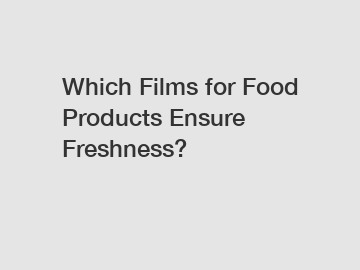Feb. 09, 2024
Packaging & Printing
Firsta are exported all over the world and different industries with quality first. Our belief is to provide our customers with more and better high value-added products. Let's create a better future together.
Which Films for Food Products Ensure Freshness?
When it comes to ensuring the freshness of food products, the choice of packaging film plays a crucial role. The right film can significantly extend the shelf life of products, keep them safe from contamination, and preserve their quality. In this article, we will explore the different types of films that are commonly used in the food industry to ensure freshness, their advantages and disadvantages, as well as their impact on the overall food supply chain.

1. Oxygen Barrier Films.
One of the main factors that contribute to food spoilage is the presence of oxygen. Oxygen barrier films, such as ethylene vinyl alcohol (EVOH) and polyvinylidene chloride (PVDC), are widely used in food packaging to prevent oxygen from entering the package. These films have excellent oxygen barrier properties, which help in preserving the freshness of perishable products like meat, cheese, and snacks. By limiting oxygen exposure, these films slow down the oxidation process and inhibit the growth of aerobic bacteria, thus extending the shelf life of the food.
2. Moisture Barrier Films.
Moisture is another significant factor that affects the quality and freshness of food products. Moisture barrier films, like polyethylene (PE) and polypropylene (PP), are commonly used to protect food items from moisture absorption and loss. These films are effective in preventing the migration of water vapor into the package, which can lead to spoilage, mold growth, and texture changes. Moisture barrier films are particularly essential for maintaining the crispness of snacks, preventing freezer burn on frozen products, and preserving the moisture content of fresh produce.
3. Light-Blocking Films.
Exposure to light can cause food products to deteriorate rapidly, resulting in loss of color, vitamin degradation, and off-flavors. Light-blocking films, such as metallized films and opaque materials like foil, are used to protect light-sensitive food items like dairy products, beverages, and certain fruits and vegetables. These films act as a shield, blocking harmful UV rays and visible light, thus hindering the photochemical reactions that lead to quality deterioration. By keeping products away from light exposure, light-blocking films help in maintaining their freshness and nutritional value.
4. Antimicrobial Films.
To combat the growth of bacteria and other microorganisms, antimicrobial films are employed in food packaging. These films are typically infused with antimicrobial agents like silver nanoparticles or essential oils. The antimicrobial properties of these films inhibit the proliferation of pathogens, extending the shelf life of food products and reducing the risk of foodborne illnesses. Antimicrobial films are commonly used for perishable items like deli meats, seafood, and ready-to-eat meals.
In conclusion, the choice of packaging film for food products can have a significant impact on their freshness and quality. Oxygen barrier films prevent oxidation and bacterial growth, moisture barrier films protect against moisture-related spoilage, light-blocking films preserve color and nutritional value, and antimicrobial films inhibit the growth of pathogens. By carefully selecting the appropriate film, food manufacturers can ensure the longevity and safety of their products, contributing to a more efficient and sustainable food supply chain.
Want more information on bopp film label? Feel free to contact us.
Previous: Which Innovative Pet Media Bottle Keeps Your Furry Friend Hydrated and Entertained?
Next: Revolutionizing Meal Prep: Are Microwavable Food Bags a Game Changer?
If you are interested in sending in a Guest Blogger Submission,welcome to write for us!
All Comments ( 0 )